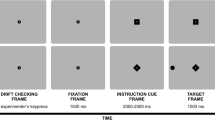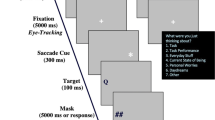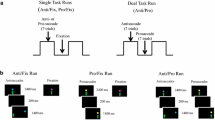Abstract
Eye movements have been used extensively to assess information processing and cognitive function. However, significant variability in saccade performance has been observed, which could arise from methodological variations across different studies. For example, prosaccades and antisaccades have been studied using either a blocked or interleaved design, which has a significant influence on error rates and latency. This is problematic as it makes it difficult to compare saccade performance across studies and may limit the ability to use saccades as a behavioural assay to assess neurocognitive function. Thus, the current study examined how administration mode influences saccade related preparatory activity by employing pupil size as a non-invasive proxy for neural activity related to saccade planning and execution. Saccade performance and pupil dynamics were examined in eleven participants as they completed pro- and antisaccades in blocked and interleaved paradigms. Results showed that administration mode significantly modulated saccade performance and preparatory activity. Reaction times were longer for both pro- and antisaccades in the interleaved condition, compared to the blocked condition (p < 0.05). Prosaccade pupil dilations were larger in the interleaved condition (p < 0.05), while antisaccade pupil dilations did not significantly differ between administration modes. Additionally, ROC analysis provided preliminary evidence that pupil size can effectively predict saccade directional errors prior to saccade onset. We propose that task-evoked pupil dilations reflect an increase in preparatory activity for prosaccades and the corresponding cognitive demands associated with interleaved administration mode. Overall, the results highlight the importance that administration mode plays in the design of neurocognitive tasks.





Similar content being viewed by others
References
Ansari TL, Derakshan N, Richards A (2008) Effects of anxiety on task switching: Evidence from the mixed antisaccade task. Cogn Affect Behav Neurosci 8(3):229–238
Aston-Jones G, Cohen JD (2005) An integrative theory of locus coeruleus-norepinephrine function: adaptive gain and optimal performance. Annu Rev Neurosci 28:403–450
Ayala N, Heath M (2020) Executive dysfunction following a sport-related concussion is independent of task-based symptom burden. J Neurotrauma. https://doi.org/10.1089/neu.2019.6865
Cherkasova MV, Manoach DS, Intriligator JM, Barton JJ (2002) Antisaccades and task-switching: interactions in controlled processing. Exp Brain Res 144(4):528–537
Clark JJ (1999) Spatial attention and latencies of saccadic eye movements. Vision Res 39(3):585–602
Coe BC, Munoz DP (2017) Mechanisms of saccade suppression revealed in the anti-saccade task. Philos Trans R Soc B: Biol Sci 372(1718):20160192
Connolly JD, Goodale MA, Goltz HC, Munoz DP (2005) fMRI activation in the human frontal eye field is correlated with saccadic reaction time. J Neurophysiol 94(1):605–611
Curtis CE, Connolly JD (2008) Saccade preparation signals in the human frontal and parietal cortices. J Neurophysiol 99(1):133–145
Dafoe JM, Armstrong IT, Munoz DP (2007) The influence of stimulus direction and eccentricity on pro-and anti-saccades in humans. Exp Brain Res 179(4):563–570
Dalmaso M, Castelli L, Galfano G (2020) Microsaccadic rate and pupil size dynamics in pro-/anti-saccade preparation: the impact of intermixed vs. blocked trial administration. Psychol Res 84(5):1320–1332
Derakshan N, Ansari TL, Hansard M, Shoker L, Eysenck MW (2009) Anxiety, inhibition, efficiency, and effectiveness: an investigation using the antisaccade task. Expl psychol 56(1):48
DeSimone JC, Weiler J, Aber GS, Heath M (2014) The unidirectional prosaccade switch-cost: correct and error antisaccades differentially influence the planning times for subsequent prosaccades. Vision Res 96:17–24
DeSouza JF, Menon RS, Everling S (2003) Preparatory set associated with pro-saccades and anti-saccades in humans investigated with event-related FMRI. J Neurophysiol 89:1016–1023 (pmid:12574477)
Edelman JA, Goldberg ME (2003) Saccade-related activity in the primate superior colliculus depends on the presence of local landmarks at the saccade endpoint. J Neurophysiol 90(3):1728–1736
Ethridge LE, Brahmbhatt S, Gao Y, Mcdowell JE, Clementz BA (2009) Consider the context: blocked versus interleaved presentation of antisaccade trials. Psychophysiology 46(5):1100–1107
Evdokimidis I, Smyrnis N, Constantinidis T, Stefanis N, Avramopoulos D, Paximadis C, Stefanis C (2002) The antisaccade task in a sample of 2006 young men. Exp Brain Res 147(1):45–52
Everling S, Munoz DP (2000) Neuronal correlates for preparatory set associated with pro-saccades and anti-saccades in the primate frontal eye field. J Neurosci 20(1):387–400
Everling S, Dorris MC, Munoz DP (1998) Reflex suppression in the anti-saccade task is dependent on prestimulus neural processes. J Neurophysiol 80(3):1584–1589
Everling S, Dorris MC, Klein RM, Munoz DP (1999) Role of primate superior colliculus in preparation and execution of anti-saccades and pro-saccades. J Neurosci 19(7):2740–2754
Fischer B, Weber H (1992) Characteristics of “anti” saccades in man. Exp Brain Res 89(2):415–424
Ford KA, Goltz HC, Brown MR, Everling S (2005) Neural processes associated with antisaccade task performance investigated with event-related FMRI. J Neurophysiol 94(1):429–440
Frischen A, Bayliss AP, Tipper SP (2007) Gaze cueing of attention: visual attention, social cognition, and individual differences. Psychol Bull 133(4):694
Furlan M, Smith AT, Walker R (2016) An fMRI investigation of preparatory set in the human cerebral cortex and superior colliculus for pro- and anti-saccades. PLoS One 11(7):e0158337. https://doi.org/10.1371/journal.pone.0158337
Hallett PE (1978) Primary and secondary saccades to goals defined by instructions. Vis Ress 18:1279–1296
Heath M, Shellington E, Titheridge S, Gill DP, Petrella RJ (2017) A 24-week multi-modality exercise program improves executive control in older adults with a self-reported cognitive complaint: evidence from the antisaccade task. J Alzheimers Dis 56(1):167–183
Hess EH, Polt JM (1964) Pupil size in relation to mental activity during simple problem-solving. Science 143(3611):1190–1192
Hutchison KA, Moffitt CC, Hart K, Hood AV, Watson JM, Marchak FM (2020) Measuring task set preparation versus mind wandering using pupillometry. J Exp Psychol Learn 46(2):280–295
Jainta S, Vernet M, Yang Q, Kapoula Z (2011) The pupil reflects motor preparation for saccades-even before the eye starts to move. Front Hum Neurosci 5:97
Klingner J, Tversky B, Hanrahan P (2011) Effects of visual and verbal presentation on cognitive load in vigilance, memory, and arithmetic tasks. Psychophysiology 48(3):323–332
Lehmann SJ, Corneil BD (2016) Transient pupil dilation after subsaccadic microstimulation of primate frontal eye fields. J Neurosci 36(13):3765–3776
Mathôt S (2018) Pupillometry: psychology, physiology, and function. J Cognit, 1(1).
McDowell JE, Myles-Worsley M, Coon H, Byerley W, Clementz BA (1999) Measuring liability for schizophrenia using optimized antisaccade stimulus parameters. Psychophysiology 36(1):138–141
McDowell JE, Brown GG, Paulus M, Martinez A, Stewart SE, Dubowitz DJ, Braff DL (2002) Neural correlates of refixation saccades and antisaccades in normal and schizophrenia subjects. Biol Psychiatr 51(3):216–223
Munoz DP, Everling S (2004) Look away: the anti-saccade task and the voluntary control of eye movement. Nat Rev Neurosci 5(3):218–228
O’Driscoll GA, Alpert NM, Matthysse SW, Levy DL, Rauch SL, Holzman PS (1995) Functional neuroanatomy of antisaccade eye movements investigated with positron emission tomography. Proc Natl Acad Sci USA 92:925–929 (pmid:7846080)
Olk B, Kingstone A (2003) Why are antisaccades slower than prosaccades? A novel finding using a new paradigm. NeuroReport 14(1):151–155
Pierce JE, McCardel JB, McDowell JE (2015) Trial-type probability and task-switching effects on behavioral response characteristics in a mixed saccade task. Exp Brain Res 233(3):959–969
Pierrot-Deseilligny CH, Rivaud S, Gaymard B, Agid Y (1991) Cortical control of reflexive visually-guided saccades. Brain 114(3):1473–1485
Pierrot-Deseilligny C, Müri RM, Ploner CJ, Gaymard B, Demeret S, Rivaud-Pechoux S (2003) Decisional role of the dorsolateral prefrontal cortex in ocular motor behaviour. Brain 126(6):1460–1473
Rajkowski J, Kubiak P, Aston-Jones G (1994) Locus coeruleus activity in monkey: phasic and tonic changes are associated with altered vigilance. Brain Res Bull 35(5–6):607–616
Smyrnis N (2008) Metric issues in the study of eye movements in psychiatry. Brain Cogn 68(3):341–358
Wang CA, Boehnke SE, White BJ, Munoz DP (2012) Microstimulation of the monkey superior colliculus induces pupil dilation without evoking saccades. J Neurosci 32(11):3629–3636
Wang J, Tian J, Wang R, Benson V (2013) Increased attentional focus modulates eye movements in a mixed antisaccade task for younger and older adults. PLoS One 8(4):e61566
Wang CA, Brien DC, Munoz DP (2015) Pupil size reveals preparatory processes in the generation of pro-saccades and anti-saccades. Eur J Neurosci 41(8):1102–1110
Winn MB, Wendt D, Koelewijn T, Kuchinsky SE (2018) Best practices and advice for using pupillometry to measure listening effort: An introduction for those who want to get started. Trends Hear 22:2331216518800869
Zeligman L, Zivotofsky AZ (2017) Back to basics: The effects of block vs. interleaved trial administration on pro-and anti-saccade performance. PLoS One 12(2):e0172485
Author information
Authors and Affiliations
Corresponding author
Additional information
Communicated by Bill J Yates.
Publisher's Note
Springer Nature remains neutral with regard to jurisdictional claims in published maps and institutional affiliations.
Rights and permissions
About this article
Cite this article
Ayala, N., Niechwiej-Szwedo, E. Effects of blocked vs. interleaved administration mode on saccade preparatory set revealed using pupillometry. Exp Brain Res 239, 245–255 (2021). https://doi.org/10.1007/s00221-020-05967-9
Received:
Accepted:
Published:
Issue Date:
DOI: https://doi.org/10.1007/s00221-020-05967-9




